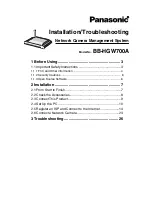
NovaLynx Corporation__________________________________________________________________________________
260-2520
Page 6
June 2021
5
INSTALLATION
To ensure best accuracy the rain gauge must be mounted as level as possible.
The gauge may be placed on any level surface, but will require supports to
ensure it cannot tip over during high winds.
The NovaLynx 260-2520S Support Bracket (sold separately) is recommended to
support and brace the rain gauge. The bracket has mounting holes on the
bottom and on one side, allowing it to be bolted to a horizontal or vertical
surface.
260-2520S Support Bracket
1.
Remove the measuring stick from the gauge. Store the measuring stick in a location where it
will be protected from the weather.
2.
Remove the funnel from the body of the rain gauge by lifting straight up.
3.
Clean out any packing materials that may be inside the gauge.
4.
Make sure the measuring tube is resting inside the measuring tube holder, and that the open
end of the measuring tube is facing upwards.
5.
Replace the funnel.
6.
Place the rain gauge in the support bracket.
7.
Use a carpenter's level across the top of the funnel to ensure the rain gauge is level. Adjust the
support bracket as needed.
6
OPERATION
Prior to the onset of a storm, prepare the rain gauge by making sure it is empty of debris. Clean out all
twigs, leaves, insects, sediment, etc. Rinse the parts with clean water and dry them.
Rain Storms:
If temperatures during the storm are expected to be above freezing, re-assemble the
measuring tube and funnel onto the gauge, and place the gauge in the support bracket.
Ice/Snow Storms:
If the storm is expected to include sleet/snow/hail, do not install the funnel or
measuring tube. Place only the outer body of the rain gauge in the mounting
bracket. Store the funnel, measuring tube, and measuring stick indoors.
Note:
Whether the collected precipitation is rain or snow, there is the possibility that the water
collected in the gauge will freeze if night-time temperatures are low enough. Since water expands
when it freezes, the body of the rain gauge or measuring tube may be damaged. Damage due to
freezing is not covered under the warranty. To prevent damage due to freezing, an anti-freeze may be


























